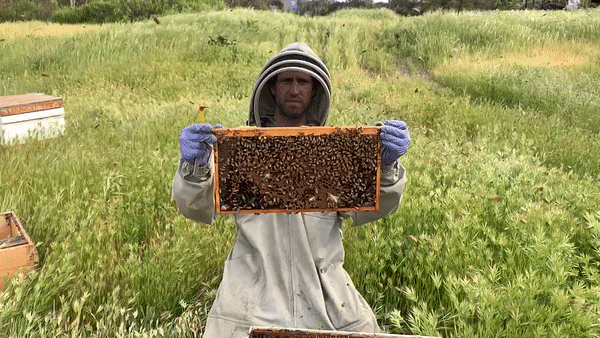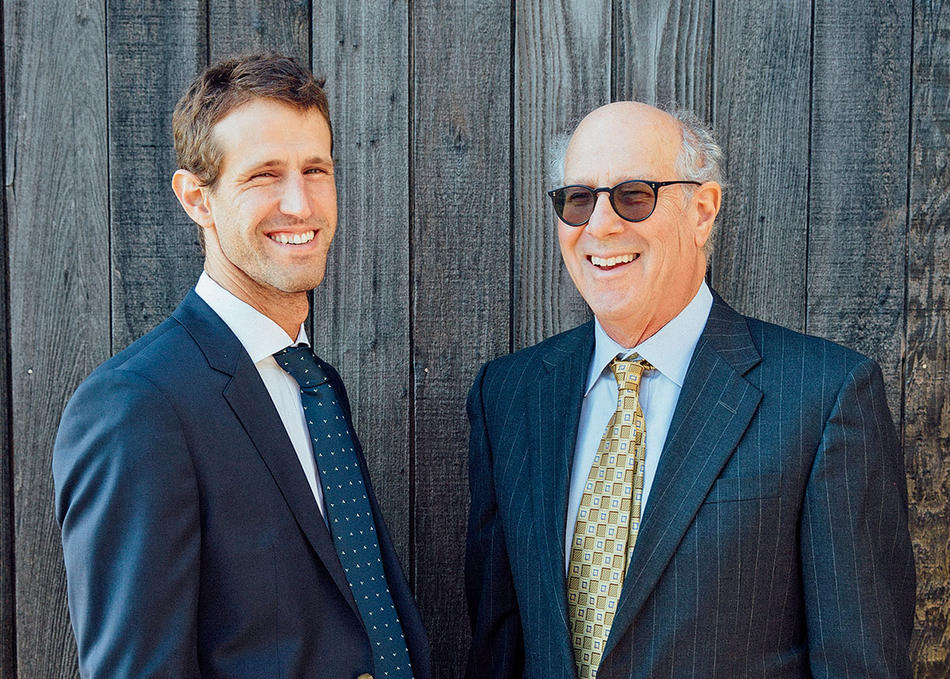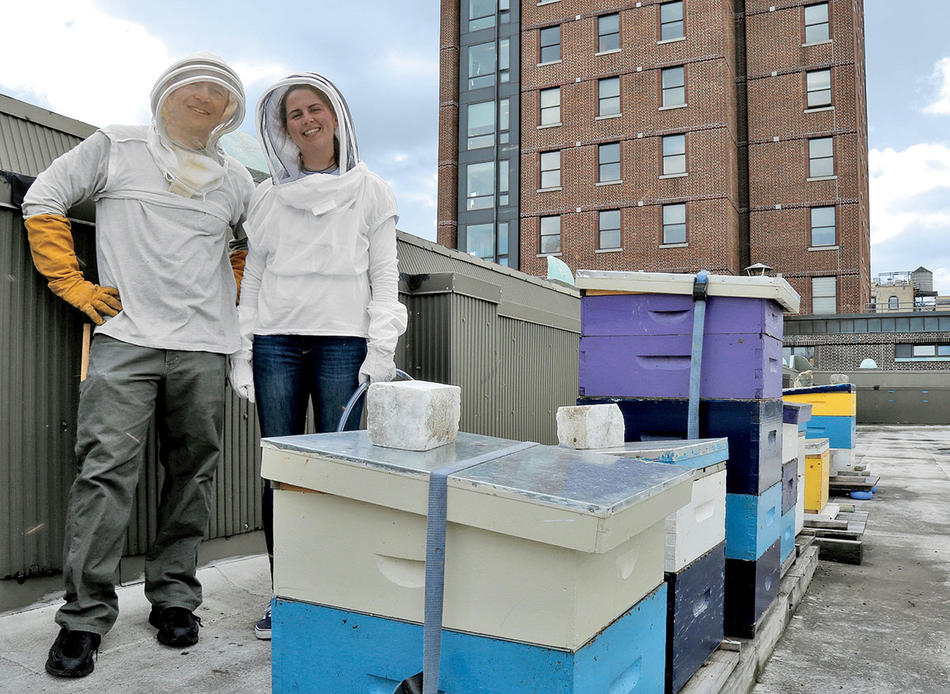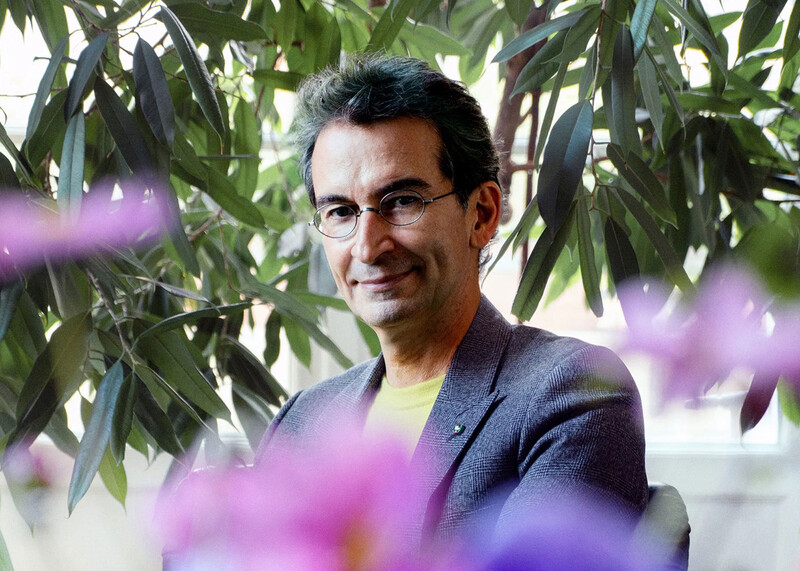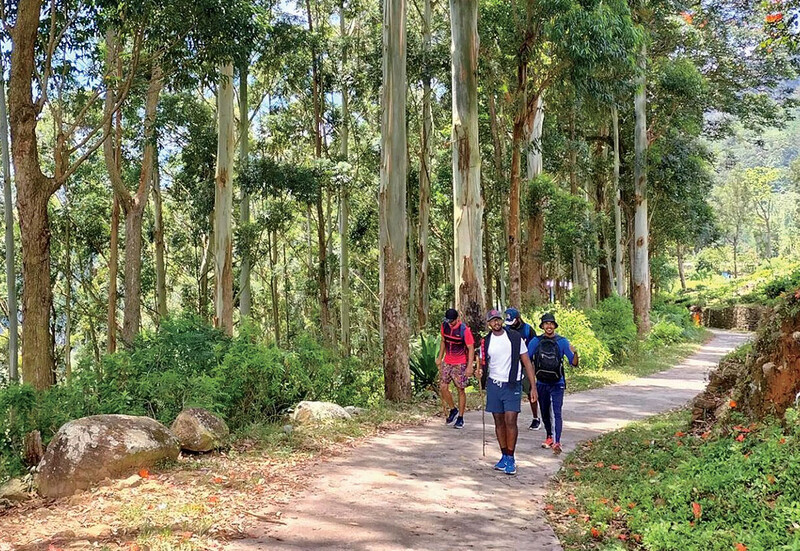
If there’s a bee heaven, it might look like Rustic Canyon, a wooded, blossomy ravine carved into the Santa Monica Mountains a short distance from the Pacific Ocean. Flourishing with California pepper trees, red-fruited sumac, frilly lilac, purple sage, and creamy jasmine, this pocket of Los Angeles is home to rambling cedar-shingled houses and luscious gardens. Nature hums sweetly here. The daytime temperature is a dependable 72°F. Dogs bark. Birds dart among the trees. And near one of the houses, under a canopy of sycamores, stands a cluster of wooden boxes painted green, yellow, pink, and blue. The boxes are stacked three high and set a few feet apart. Each stack — there are ten in all — is a beehive, and each hive contains some sixty thousand honeybees.
Eli Lichter-Marck ’08CC grew up in Rustic Canyon, and his father and business partner, Nick Marck ’71CC, still lives here. Their company, Eli’s Bees, which they formed in 2010, sells honey and candles derived from the efforts of bees plump with the nectar of Santa Monica Canyon, Topanga Canyon (where Eli lives), and Malibu. The delicate honeys, imbued with the perfume and sunshine of this temperate landscape, are sold to juice bars, natural-food stores, and private customers. For Eli, honey is not the heart of the business but the glaze on a cake made of biology, botany, and climate science. Nurturing bees poses daily riddles that Eli thrives on untangling, and which bring him ever closer to the buzzing intelligence of another world.
“Bees are remarkable creatures and remarkable teachers,” Eli says as he crosses a small footbridge over a creek and approaches the hives. “If you’re patient and pay attention, the bees will tell you what they need.”
At thirty-four, Eli possesses the earthy wisdom of someone intimately acquainted with the life vibrations of a different species. You might call him the bard of bees, the Homer of honey — an example of what can happen when the Core Curriculum cross-pollinates with the natural world. Eli majored in architecture at Columbia, but it was a Shakespeare professor whose advice led him, years later, to the bees. And though he could not have imagined in college that he’d someday become a full-time beekeeper, he now glows with love for these fragile creatures — and he has hitched his fortune to theirs.
“With beekeeping you basically get to connect with a wild animal,” Eli says with a certain awed reverence. “No mammal is as weird to us as a bee. Cows are like gentle humans. Sheep are like dummy humans. But bees are super smart — they really know what they’re doing, and they will not let you make mistakes, because if you make a mistake they’ll sting you, and it hurts.”
Parked in the dirt next to the hives is Eli’s 1992 Dodge pickup. From the truck’s bed Eli grabs a protective veil, a smoker (a device that blows smoke into the hive to pacify the bees), a flat, metal all-purpose implement called a hive tool, and a brush to remove clingy bees from the rectangular frames on which they build their honeycombs.
Flitting outside the hives are guard bees, whose job is to defend the colony from invaders like hornets, yellow jackets, and humans. These worker bees may live just five to six weeks, and their duties change as they age: they start as nurse bees, graduate to being housekeepers and guards, and finally become foragers who gather nectar for the colony.
Eli fills the smoker with some burlap, lights it, and squeezes a little smoke into the hive. The bees become visibly fuddled. “It’s sort of a ‘Whoa, what the hell is that?’” says Eli. “Bees give off an alarm pheromone when there’s an intruder, and the smoke masks that response. If we opened this hive without smoke, we’d be running.”
Using the hive tool, he pries open one of the boxes and pulls out a frame, which is covered with hundreds of slightly addled bees, some of which crawl onto Eli’s fingers. “I have enough experience to know what I can and cannot do,” he says. Eli loosens the bees from the frame with the brush, revealing the wondrous design of the honeycomb, which serves as both an incubation chamber and a winter food bank. “The architecture is really interesting,” he says, noting the wax structure’s finely wrought hexagonal compartments, or cells. “With the hexagonal shape, every wall of each cell is shared by another cell wall, so it’s incredibly efficient. Bees make wax from glands in their abdomen, which takes a lot of energy, but they don’t need very much wax to make a lot of space. Each frame in the hive can hold four pounds of honey — that’s an enormous amount of volume inside the surface area.”
He points to the bottom box, called the brood box, which holds the queen. “Inside, it’s pitch-black,” says Eli. “The queen, who lives around three or four years and mates early in her adult life with about a dozen drones, will walk around, and the other bees will smell her and form a ring around her and say, ‘Lay an egg here, lay an egg here.’ She’ll stick her backside into the cell and lay an egg, which is fertilized with sperm that she has stored in a pouch called a spermatheca. At her peak she’ll lay 1,200 to 1,600 eggs a day.”
Fertilized eggs will become female worker bees; new queens are selected by colony consensus, with nurse bees feeding the chosen larvae a diet of royal jelly, a white substance that nurse bees secrete in order to nurture a queen. “The reason she becomes a queen instead of a worker is because of the special mix of proteins in the royal jelly, which determines her development,” Eli says. The small fraction of eggs that the queen decides not to fertilize will become males, called drones, whose sole purpose is to mate with a new queen. After mating, the queen, with the drone’s endophallus still inside her, will separate from him, ripping his genitals from his abdomen and sending him to the Great Bee-yond. It’s the females who build and maintain the hive and feed the colony.
“Bees can fly as far as five miles for food and find their way back to the hive,” says Eli. “They have an insanely acute visual memory. For example, if I take this beehive and move it five feet away, the bees will still come to this exact location looking for the hive. That’s because they fly out in concentric circles and memorize the landscape around the hive. They know exactly the spot they’re looking for.”
When a scout bee returns to the hive after locating fresh flowers, Eli explains, she will communicate where the food is by crawling over her sisters and performing what’s known as the “waggle dance,” a figure-eight movement punctuated after each circuit with a twitching motion. The angle of the bee’s path in relation to the sun indicates the direction of the food source (bees have an internal clock that tells them where the sun is in the sky while they’re in the hive), and the duration of the waggle determines the distance. The foragers then fly to the locale, where some draw nectar and others collect pollen, some of which sticks to their hairs and is spread from flower to flower. With the nectar stored in a sac called a honey stomach, they return to the hive and share the goods with the housekeepers, who deposit it into the cells of the honeycomb. “When the comb is filled up with nectar, the bees will fan their wings in order to dry it out,” says Eli. “And that’s what turns it into honey.”
Honey is a means for Eli, not an end; it is the ambrosial byproduct of a profound process uniting plants, insects, and people. Honeybees are one of twenty thousand bee species in the world that pollinate many of the fruit, nut, and vegetable plants that humans rely on. “In agriculture, 80 percent of our food — everything but grains, which are wind-pollinated — depends on pollinators like bees,” Eli says.
So work the honeybees,
Creatures that by a rule in nature teach
The act of order to a peopled kingdom.
— William Shakespeare, Henry V
In college, Eli took Lit Hum with Edward Tayler, the esteemed Shakespeare scholar and the professor who Eli says had the greatest influence on him. “I will never have another educational experience like that,” he says. “Tayler challenged us to find our own way of seeing things, without bullshit. He did not tolerate bullshit. He wanted you to see the thing for what it was. And that gave me an attitude for the rest of my life: I don’t want to deal with bullshit.”
It was in that spirit that Eli, after college, took off to South America. A young idealist in search of meaning, he wanted to explore landscape ecology, ancient architecture, and sustainable agriculture. He rented a car and drove through Chile, Brazil, and Venezuela, pausing to study traditional mud-brick building. He also surfed — back home, the waves off Malibu were as integral to him as the mountains — and on the Chilean coast he met a man who lived on the surf break. The man was a beekeeper, and Eli, who would have done anything to stay on his property, offered to work in exchange for lodging. That was his first brush with bees.
Meanwhile, back in Rustic Canyon, Eli’s dad was having a bee problem.
Nick Marck had studied history at Columbia, but it was a class with the film critic Andrew Sarris ’51CC, ’98GSAS that had helped light his way. “Before college I had been into doing magic,” Nick says. “This was the time of the draft, the Vietnam War, and I was trying to figure out what to do with my life. When Sarris described the role of the director as an illusionist, it really resonated with me.” After college, Nick moved to LA, worked his way up in the industry, and eventually became an in-demand director for shows like The Wonder Years, Northern Exposure, The X-Files, and Buffy the Vampire Slayer.
One day in 2010, Nick discovered that a colony of bees had taken up residence beneath the siding of his house. “All the honeybees we have here were originally introduced by farmers,” says Nick. These commercial honeybees were brought in to pollinate the orange groves that once filled LA County (just as California’s almond groves rely on honeybees shipped in from all over the country). Along the way, some bees escaped their managed hives and became naturalized in the mountains, canyons, and cities. When colonies get too big, half the bees split off — a phenomenon known as swarming. When that happens, a ball of migrating bees will settle in whatever adequate space is available. Nick’s house provided such a nook.
Nick called a bee-removal specialist named David Saraf. Eli had just returned from South America dusty with the pollen of a budding obsession, and in a twist worthy of one of Nick’s TV shows, Saraf hired Eli and became his mentor, teaching him how to remove bees from odd places (sprinkler boxes, attics) without killing them. Along the way, Eli siphoned off some bees — rescue bees, he calls them — and began stowing them in hive boxes, trying to build a healthy colony.
“So here’s the thing,” Eli says. “Keeping bees alive is not easy. For three years I tried and failed with the bees. They would make honey, but then they would disappear or die.” By then, Eli was working as a landscape architect and taking premed classes. He was almost thirty and had no definite career track. But a bug had bitten him. And he knew he must answer the fundamental question: to bee or not to bee?
Bees weren’t BS. And keeping them alive was, for Eli, a tantalizing puzzle to be solved. “My inclination,” he says, “was to go deeper and deeper.”
Americans have labored to keep their honeybees buzzing ever since European settlers brought Apis mellifera to the Virginia Colony in 1622. More recently, in the winter of 2006–07, a spate of honeybee colony failures made national headlines. Worker bees were abandoning their hives in droves — going out to gather nectar and never returning. Called colony collapse disorder, the syndrome would destroy nearly a third of honeybee colonies each year over the next several years.
At the time, Kathleen Pike, a professor of psychology at Columbia, knew nothing about bees, but she was alarmed by what she read about the widespread demise of these crucial pollinators. Scientists named a host of potential causes: pesticides, habitat loss, pathogens, parasitic mites. As Pike read more, her curiosity grew. She visited some hives, which she found “mesmerizing,” and three years ago she decided to try beekeeping in her yard in eastern Long Island. She started with three hives, in what proved to be one of the hardest, most gratifying undertakings of her life. “Bees are incredibly interesting intellectually,” she says, “but there’s also something emotionally captivating about them.” In three years she has yet to get her bees through the winter: though they generate body heat to protect the brood, they may succumb to viruses, strong storms, or temperature swings that bring them out of the hive too early. But her enthusiasm and determination have only grown.
“There are so many ways that bees can teach us and enrich our thinking,” Pike says. “For bees, the team is as important as the queen. Every bee matters, but no single bee can make it alone. They’re all in it together. During the summer, bees will make honey and store it in the honeycomb for a generation not yet born. They will not be there when the next generation consumes that honey. That’s an extraordinary message.”
Pike’s academic training makes her particularly perceptive about how humans react to bees. “Most people are afraid of bees,” she says. “When we have guests over, they’ll come out to the hives with enormous apprehension. I explain that honeybees don’t want to sting you, because after they sting you they die. I give visitors protective covering and talk about how to approach the hives and where to stand. They start out tentative, and then, within minutes, universally, they are freed from their anxiety and ready to just engage in this other world in a way that fills them with excitement and joy and curiosity.
“As a psychologist, I know that careful exposure to phobias and fears — and education — can help address issues of anxiety. I have all these converts who are now in love with the bees. It makes me think about how wrong our ideas can be without firsthand experience. There are parallels to the stigma around mental illness: connecting with someone who has had some mental-health condition, who can talk about it and make it not scary, is critical in reducing people’s prejudice.”
Since 2012, Jonathan Snow, an assistant professor of biology at Barnard College, has kept what may be, by virtue of their address — the roof of Barnard Hall — the smartest bees in town. Six hives, holding as many as 360,000 bees, provide both honey and specimens for experiments in the Snow Lab.
The Barnard bees dine amid the foliage of Riverside and Morningside Parks, upon sidewalk clover, and in the white-flowering spikes of cherry laurel and pink bracts of dogwood on Columbia’s campus. On a table in Snow’s office rest some jars containing a thick, sticky treasure the color of orange opal — 100 percent New York City honey.
Snow studies the role of infectious diseases caused by a parasite in the cells of honeybees. While the parasite is not as lethal as the Varroa destructor mite (a prime culprit in recent upticks in bee mortality), it can amount to a death knell for a stressed or diseased colony. “Stress in honeybees is likely to be felt at multiple levels: the colony level, the individual-organism level, and the cellular level,” Snow says. “Climate change, which involves things like heat stress, can trigger the same pathways that we’re studying. Pesticides result in cell stress. Nutritional stress due to habitat loss affects these pathways as well.”
For Snow, this tenuous state raises broader questions: “If honeybees are struggling, what about the other bee species — bumblebees, carpenter bees, leafcutter bees — that people don’t care about as much, but which are critical to our agricultural and natural ecosystems? And what about all the other invertebrates that are going to be facing similar issues?”
Out west, the effects of climate change have already turned tens of thousands of acres of bee paradise into hell. In the spring of 2018, Eli had 160 hives spread out in nearby mountains. But that fall, wildfires rampaged through the region, carpeting the hills and pouring into the canyons. Eli lost half his bees, along with “a ton of equipment.” His hives are still recovering — slowly — but Eli considers himself lucky: he knows people who lost every beehive they had. Two years later, he finds a silver lining in all that lost gold. “Where the fires burned,” he says, “a whole new world of flowers came up.”
Beekeepers refer to times of heavy bloom and nectar-gathering as the “honey flow,” the bread and butter of beekeeping. In Southern California, Eli’s bees start making honey in April. Eli does an April harvest, another in early summer, and another in September. “Every plant species makes a different kind of nectar,” he says. “Honeybees prefer to harvest from one type of plant at a time. They’re opportunists and generalists when it comes to flowers. Certain bees and wasps are specialists and only go for one certain flower. Honeybees will go for anything.”
Eli is a “sideline” beekeeper, someone who has between ten and two hundred hives. Fewer than ten and you’re a hobbyist; more than two hundred and you’re an industrial-scale enterprise. Eli is an indie guy, a surfer in a bee suit, ruggedly farming exquisite honeys, each from its own type of flower and each with its own color and texture and subtle flavors.
He takes off his veil and drops it in the back of his truck. On the edge of the tailgate, a half dozen jars of honey are lined up, their hues of amber and orange and red catching sunbeams and glowing from within, a distillation of nature’s harmonies. Eli offers an impromptu tasting. The light, distinct notes in each sample are as far from characterless commercial squeeze-bear honey as just-picked wildflowers are from a supermarket bouquet. This honey is, no joke, the nectar of the gods, brokered by a truth-seeker, a few million bees, and, in no small way, a professor of Shakespeare.
“I’ve always been a do-my-own-thing kind of guy,” says Eli, “and in college, Professor Tayler tried to rein me in and keep me focused on the work. One time I met with him and said, ‘I don’t know what to do, Dr. Tayler. What should I do with my life?’ The way an undergrad will. And Tayler looked at me and said, ‘Wait as long as you can before you decide.’
“So I stopped worrying about it and went with the flow. I’d been so worried, not knowing what to major in or what to do, and Tayler just put me at ease. And it changed my life. I thought: I’ll just figure it out. And then I waited a really long time, until the bees found me.”
This article appears in the Spring/Summer 2020 print edition of Columbia Magazine with the title "A Taste of Honey."
